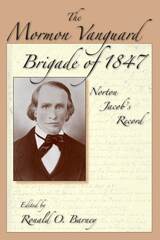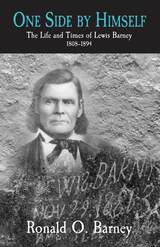2 books about Barney, Ronald

Mormon Vanguard Brigade Of 1847
Norton Jacob's Record
edited by Ronald O. Barney
Utah State University Press, 2005
There are no historical events that have more iconic significance for the people of Utah than the trek of the vanguard company of Mormons west in 1847. Its meaning may vary, but overall, the march has a highly symbolic and seminal historical importance for virtually all Utahns. While the journey has been widely celebrated, memorialized, and even sanctified and various books have been written about it, there is more that can be said and understood about the migration's place in western history; about its context, including events preceding and following it; and about the real experiences of its participants. Particularly lacking in most published accounts are the stories of the rank and file members, the individuals who, in contrast to the well-known leadership, with Brigham Young at the top, might fittingly be called foot soldiers. The 1847 company had a military-like organization, which is captured by Ronald Barney's term brigade in the title. Norton Jacob was such a man of the ranks in 1847. He had no special status in the Mormon Church, and there was little to make him stand out in the historical record than that he left what is regarded by many trail historians as one of the best and most informative journals of the early Mormon emigration. While the heart of Jacob's record concerns the 1847 journey, there is much more to it. The diary published here begins in 1844, the year of church founder Joseph Smith's murder. It continues through the crisis events that followed: the Mormons' flight from Nauvoo, their trudging journey across Iowa to Winter Quarters, and the beginnings of mass migration to Utah. After the apex of 1847, the arc of the narrative moves through accounts of Jacob's return to Nauvoo late that year and of the much larger Mormon emigration in 1848. It reaches denouement in a short record of his first years in Salt Lake Valley.
[more]

One Side By Himself
Ronald Barney
Utah State University Press, 2002
"What an astonishing life and what a remarkable biography. Lewis Barney's sojourn on the hard edge of the American frontier is a forgotten epic. Not only does this book tell of an amazing personal odyssey from his birth in upstate New York in 1808 to his death in Mancos, Colorado, in 1894, but Barney's tale represents a living evocation of some of the most significant themes in American history. Frederick Jackson Turner theorized that the frontier shaped our national character, but Lewis Barney's life stands as a testament to the real impact of the westering experience on a man and his family. Ron Barney's detailed biography of Lewis Barney provides a participant's view of Mormonism's first six decades of controversy, hardship, and triumph, viewed from the bottom of the social heap. Despite his wide-ranging experience and endless sacrifices, Lewis Barney was a worker in the Mormon vineyard, not one of the princes of the Kingdom of God whose lives have been so exhaustively celebrated. Barney's lack of status in this complex hierarchy adds tremendously to the value of this study, since so much nineteenth-century LDS biography has ignored the lives of ordinary people to celebrate a surprisingly small elite whose experiences were far different from those of the general Mormon population." —Will Bagley, editor of the series Kingdom in the West: The Mormons and the American Frontier and editor of The Pioneer Camp of the Saints: The 1846-1847 Mormon Trail Journals of Thomas Bullock.
[more]
READERS
Browse our collection.
PUBLISHERS
See BiblioVault's publisher services.
STUDENT SERVICES
Files for college accessibility offices.
UChicago Accessibility Resources
home | accessibility | search | about | contact us
BiblioVault ® 2001 - 2024
The University of Chicago Press









